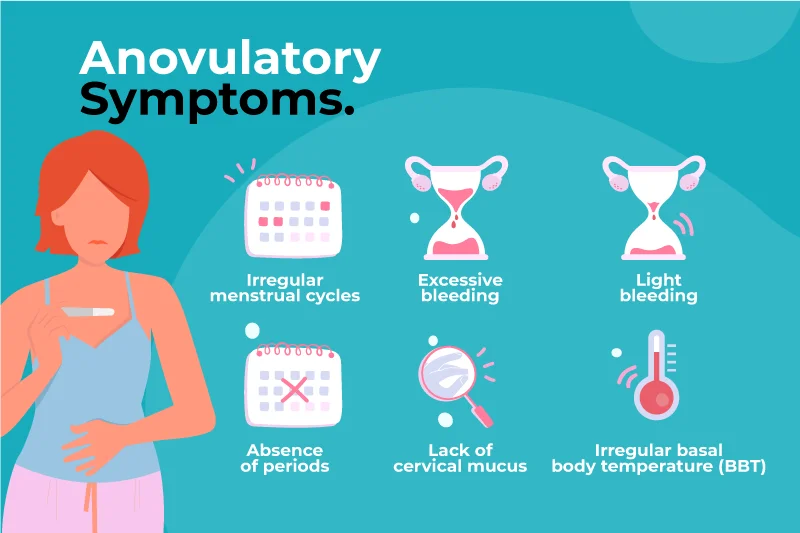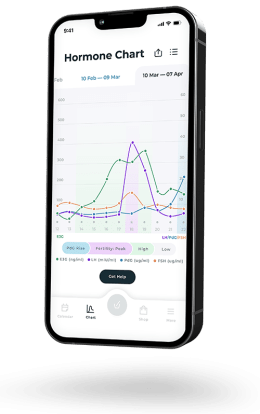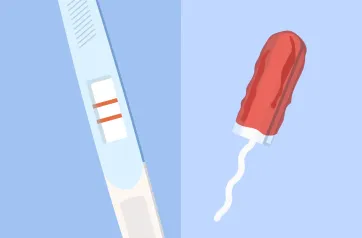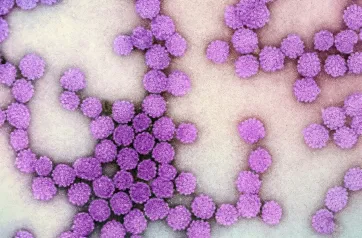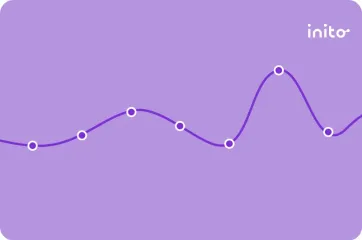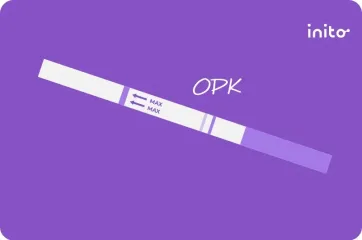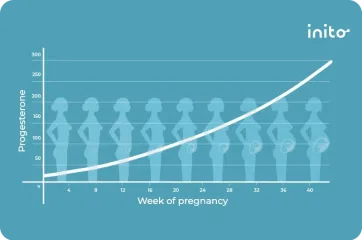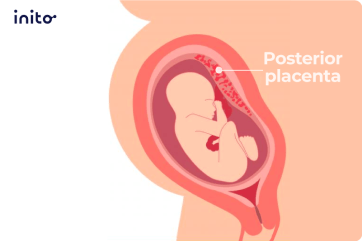Content table
Confused about why you’re not becoming pregnant? Tired of getting negative pregnancy tests?
Are you worried you might be having anovulatory cycles? If the process of becoming pregnant has you feeling overwhelmed and even a little depressed, you’re not alone!
One of the biggest hurdles for many individuals trying to get pregnant is figuring out their ovulation schedule.
The meeting of egg and sperm may have seemed like an easy process in your middle school science class.
Unfortunately, getting the timing right in real life may involve some tracking with the help of ovulation trackers.
If you’ve been tracking your periods for months trying to get pregnant, you might be surprised to learn that having a period does not necessarily mean you’ve ovulated.
Some women experience what appears to be a period even when eggs are not released from their ovaries.
Confused? Allow us to introduce you to anovulatory cycles.
Key Takeaways
- Ovulation is the part of the menstrual cycle when an egg is released from the ovary. It typically occurs 12-14 days before your next period.
- Anovulation is the absence of ovulation during the menstrual cycle.
- Occasional anovulation is normal, but if you’re experiencing it for many months in a row, it can make becoming pregnant difficult.
- Common signs of anovulation are irregular periods, light/heavy menstrual bleeding, not experiencing periods, and/or a lack of cervical mucus.
- Just because you experience menstrual bleeding doesn’t mean you have actually ovulated.
- Inito tracks FSH, estrogen, LH, and PdG (urine metabolite progesterone) levels all in a single test strip (unlike other at-home ovulation tests). So you can actually know if you have ovulated.
- Hormonal shifts are the cause of anovulation more often than not.
- These hormonal imbalances may be due to your age, lifestyle, any disease, or as a result of the medications you are taking.
- Doctors will choose a treatment plan based on the cause of your anovulation.
- Treatment for anovulation may require lifestyle changes (diet, exercise, stress level, etc.), medication, or surgery.
But first… what is ovulation and how does it work?
Ovulation is the part of the menstrual cycle when an egg is released from the ovary.
It typically occurs 12-14 days before your next period (so around day 14 of a 28-day-cycle), but the exact timing may vary.
The reason why your ovulation timing varies is your hormonal cycle. Releasing an egg from your ovary is not a simple task. Your brain is involved in it along with specific hormones.
First, the hypothalamus secretes gonadotropin-releasing hormone (GnRH). This causes another gland in the brain, called the pituitary gland, to release follicle-stimulating hormone (FSH).
Once released, FSH helps the egg to develop and stimulates the hormone estrogen to build up the uterine lining. The body does this to offer a good home to the fertilized egg.
Once the egg is mature, your body will experience an increase in Luteinizing hormone (LH) or the “LH surge” as it is commonly called. This causes the body to release the egg from the ovary into the fallopian tube. Ovulation can occur about 24 to 36 hours after the LH surge.
After you ovulate, you’re in the second half of your cycle, the postovulatory phase.
Progesterone is the dominant hormone in this part of the cycle, and it supports the lining of the uterus for a potential pregnancy.
If you become pregnant, progesterone levels stay high preventing a period. If the egg is unfertilized, you will stop producing progesterone and have a period.
Because eggs have a limited window of time during which they can be fertilized, if you’re hoping to become pregnant knowing when ovulation is occurring is very beneficial. The days around ovulation are critical to the conception process!
Ok, so what is anovulation?
Anovulation is the absence of ovulation. If you’d prefer to think of it another way, anovulation occurs when an egg is not released from the ovaries during a menstrual cycle.
How Often Does A Woman Have An Anovulatory Cycle? (Can I Have An Anovulatory Cycle Every Month?)
Experiencing an anovulatory cycle once or twice a year is perfectly normal. For most women, an anovulatory cycle may be lost in between two normal ovulatory cycles. Many other women may experience anovulatory cycles multiple times in a row. This chronic problem is the primary cause of infertility.
In fact, approximately 30% of female infertility is the result of anovulation. Chronic anovulatory cycles can pose a fertility problem.
So how do you know that you are experiencing anovulation, and what steps will your doctor take to identify/treat it?
Anovulation symptoms/signs of anovulation
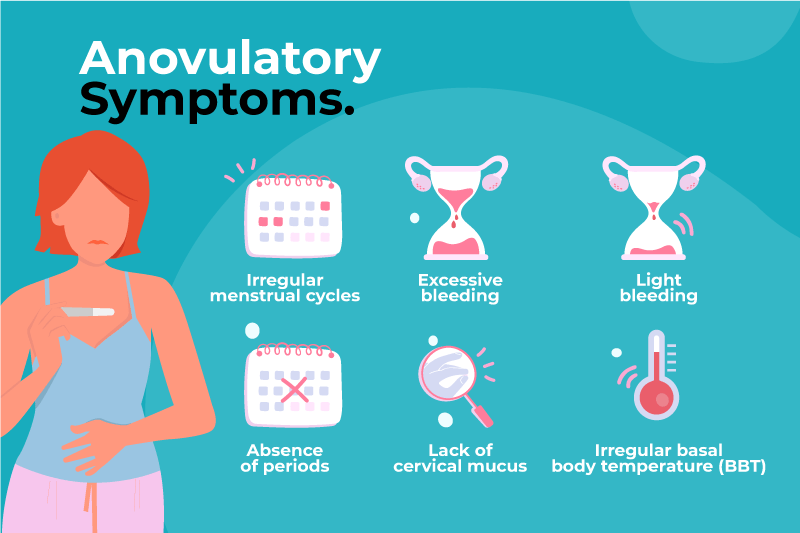
Some common symptoms of anovulation are:
- Irregular periods
- Excessive or light menstrual bleeding
- Non-existent periods
- Lack of cervical mucus
Because you may still experience period-like bleeding during months when an egg has not been released, you won’t be able to confirm ovulation based on your period. You’ll need to use another method to confirm anovulation.
Anovulation diagnosis
Over-the-counter ovulation tests may seem like an easy way to know if you’ve ovulated or not.
However, these tests measure only your LH levels and not progesterone. So, they won’t fully prove whether you ovulated.
if you believe that you are not ovulating and wish to conceive, you should see your doctor for an official diagnosis and help in addressing the situation.
Your doctor will get the following tests done –
- Blood test to check progesterone levels
- Ultrasound to check uterine lining
- Blood tests
Progesterone levels are checked for in your blood test. This helps detect if you have actually ovulated. Progesterone is released only after ovulation. So, if there is no progesterone present in your body, that means you have not ovulated.
- Ultrasound
Your uterine lining keeps growing after every period. This lining forms a bed for the fertilized egg to come and settle into. An ultrasound helps measure the uterine lining and its thickness around ovulation. The follicle growth is also monitored with the help of an ultrasound. This way, you will know when the follicle will mature and rupture to release the egg.
Unfortunately, testing can be pricey. It can also be emotionally and physically exhausting if you have to head into the doctor’s office every day for follicle growth and maturity checks.
Getting yourself pricked for progesterone tests can be painful.
You can try at-home ovulation tests like the Inito Fertility Monitor. This helps track your fertile days and confirm ovulation all from the comfort of your home! It works by measuring all four hormones – FSH, estrogen, LH, and PdG (a urine metabolite progesterone).
The Inito fertility monitor tracks FSH, estrogen, LH, and PdG (a urine metabolite progesterone), so you know if you have actually ovulated or not!
Why do women experience an anovulatory cycle?
If occasional anovulation is normal, you’re probably wondering what causes it?
A common reason women experience anovulation is hormonal shifts and imbalances.
This explains why most women experience anovulatory cycles in the year following their first period and as they get closer to menopause (around ages 40 to 50).
Not all cases of anovulation are based on hormonal shifts associated with the human life cycle though.
Anovulation can also be caused by:
- Having a high or low body mass index (BMI) level
- Elevated stress levels
- Certain eating habits
- Extreme levels of exercise
- Cancer treatments
- Certain medications (epilepsy and steroid medications)
- Polycystic ovary syndrome (PCOS): This disorder affects about 1 in 10 women of childbearing age in the US. It is the most common cause for hormonal imbalance in women of this age group.
- PCOS causes a woman’s body to make excessive amounts of male hormones. The name comes from the small, typically painless cysts on the ovaries that are a common marker of the syndrome.
If you have recently stopped hormonal birth control, there is also a chance you may experience anovulation. This is because many forms of hormonal birth control (pills, patches, IUDs with hormones, etc.) are designed to stop ovulation with synthetic forms of estrogen and progesterone that can have lasting effects on the body’s hormone systems.
Anovulation treatment
Your doctor may suggest a variety of treatment options depending upon the cause of your anovulation.
If anovulation is being caused by external lifestyle choices, your doctor may recommend changes to your diet and exercise plan to restart ovulation.
Depending on your current health, this may mean you’ll need to increase or decrease the number of calories you consume every day. Your doctor may also ask you to exercise more or reduce the amount of strain you’re putting on your body.
If you’re experiencing anovulation as a result of internal imbalances, your doctor may prescribe fertility medications. These drugs can help to ripen the follicles, increase estrogen, and cause the ovaries to release eggs.
In rare situations where a serious complication is causing your anovulation, like a tumor, surgery may be necessary to address the issue.
Summing it up:
If getting pregnant is taking longer than you’d like, you may want to spend time tracking your ovulation. (Need some help with that? Don’t forget about Inito!)
Occasionally experiencing anovulation is normal, but if you discover that your body is frequently failing to ovulate, and you would like to conceive, you’ll want to talk with your doctor. (They may perform an ultrasound and draw some blood to determine why ovulation is not occurring.)
Depending on the reason you’re experiencing anovulation, your doctor may suggest lifestyle changes, prescribe medications to help encourage egg growth/release, or in rare circumstances recommend surgery.
As you make these adjustments, Inito can help you to track your fertility and confirm when ovulation has occurred. With the help of this information, baby dance during the right fertile window can ensure that a positive pregnancy test result may soon follow!

FAQs
There are a few symptoms that you can look out for that may indicate you aren’t ovulating. These include: irregular or non-existent periods, extremely heavy or light periods, a lack of cervical mucus, and fluctuating basal body temperature (BBT). Unfortunately, none of these factors officially confirms anovulation. Tracking progesterone and its urine metabolite PdG is a more reliable method since your body only releases progesterone after you ovulate. To do this, you can get blood progesterone testing done through your healthcare provider or use Inito to check your PdG levels from the comfort of your home.
The “cure” depends on the reason for your anovulation. This means you would need to treat the underlying condition or make changes to your lifestyle to resume regular ovulation. For instance, if PCOS is to blame for your irregular ovulation, you would need to treat your hormonal imbalance. If your anovulation is a result of high stress levels, you would need to find ways to better manage your stress. If you’re not sure why you’re not ovulating, it’s best to start by consulting your doctor!
There are a few lifestyle changes you can make that may help you resume ovulation. Some of these include: maintaining a healthy BMI, keeping your stress in check, and eating a well-balanced diet that supports your hormonal health. That said, if you have an underlying health condition that’s causing anovulation, you’ll also need to see your doctor about a treatment plan. In some cases, your doctor may prescribe certain fertility medications to kickstart ovulation.
It’s normal to have an anovulatory cycle every now and then (1-2 times per year). That said, if you’re not ovulating frequently, this could be a sign that something is up with your health.
Was this article helpful?
The American College of Obstetricians and Gynecologists. (2015). Fertility awareness-based methods of family planning. acog.org/Patients/FAQs/Fertility-Awareness-Based-Methods-of-Family-Planning
Anovulation. BMJ. 2003 Sep 6; 327(7414): 546–549. doi: 10.1136/bmj.327.7414.546
Mayo Clinic Staff. (2017). Polycystic ovary syndrome (PCOS). mayoclinic.org/diseases-conditions/pcos/symptoms-causes/syc-20353439
Su HW, et al. (2016). Detection of ovulation: A review of currently available methods. onlinelibrary.wiley.com/doi/pdf/10.1002/btm2.10058




